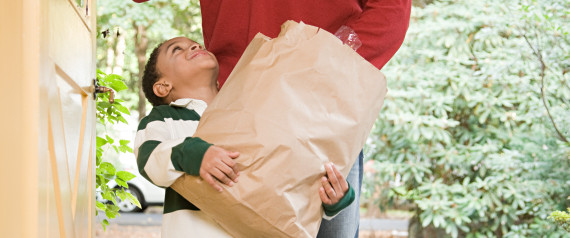Kids and Money: 4 Grocery Tips to Help Teach Your Child About Money
Posted: Updated:
1. Shop on your own turf.
There are certain items we always buy, so it's easy to estimate how much they will cost. If you aren't sure, check grocery receipts from previous trips to get an idea. Make a grocery list and write down the estimated amount next to the item on the list. Add up all of the estimated amounts before you go. Let your child see what you are doing and be a part of the process. Be sure to to have your child include their favorites to the list at this time, too. Your family will already have an idea of how much you will spend before you even leave the house.
2. Why paying in cash is king.
Have you ever tried to read the instructions for using a cell phone without actually
having the phone right in front of you? This would be an arduous task. The same is true when you explain budgeting and spending money to your kid. That's why paying in cash while shopping it vital when you are first teaching them these money concepts.
You may hear this tip over and over from financial experts. There's a reason -- it works. This is especially important to kids. If they never see how the money physically leaves when you buy something, they may not fully grasp the concept. From a teaching standpoint, if you use a credit card while grocery shopping, the brain doesn't have any context to base the concept that you are trying to teach. Be sure to explain why you are making a spending plan prior to your trip. Explain the benefits of spending a certain amount. The shopping trip will then serve as the real-world experience to connect the abstract concept to the concrete action. They will be able to make better sense of their own cents.
3. Push buttons.
Depending on your child's age and maturity level, have them calculate your spending during the shopping trip. They can be your mini bookkeeper. Children love to push buttons (both literally and figuratively). Bring an inexpensive calculator with big buttons so your child can start by punching in your allotted amount and then subtract the amount of the items you place in the shopping cart as you go. You can also use your phone with adult supervision. If you fear that they will drop it or start playing Candy Crush on it, hold the phone while they push the numbers. No matter what device you choose, if you think your child is too young or may get frustrated, you can type in the amount and have them push the subtraction button to still participate and do their "job."
4. Allot money for surprises.
While showing the importance of having a budget to stay on track is the purpose of the experience, it may not seem so glamorous to junior or your little princess (or even to you). In the back of their minds, they still may be wondering, What's in it for me? Set an allotted amount for them to choose a parent approved treat during the trip. They can also see that having a certain amount to spend actually allows you to get items you want, not just what you need. They will see that budgeting has its rewards.
The Bottom Line
Teaching your kids about money doesn't have to be so formal. Getting them involved in planning a grocery list, estimating costs and making buying decisions gives them real-world experience to better manage money in the future.




No comments:
Post a Comment